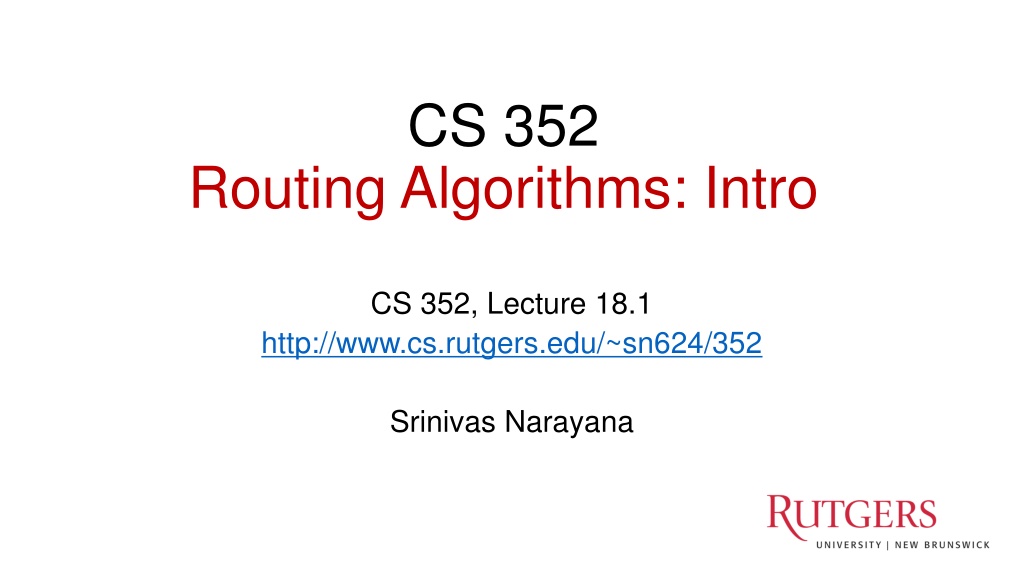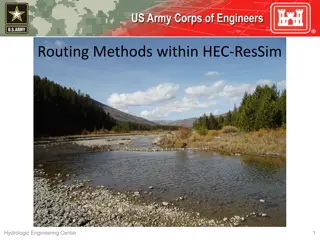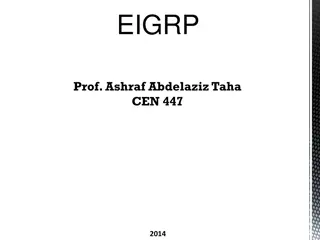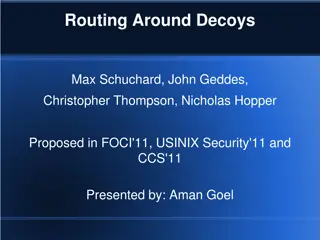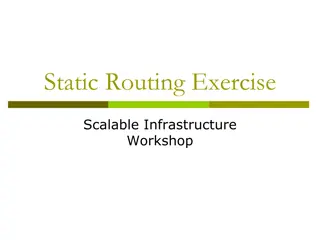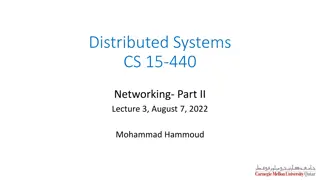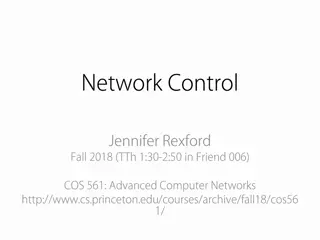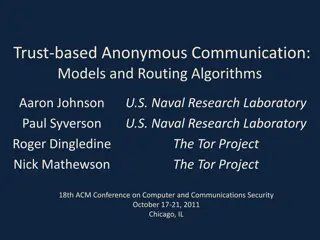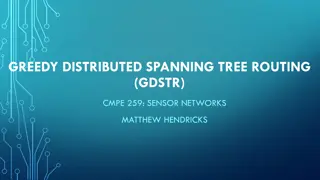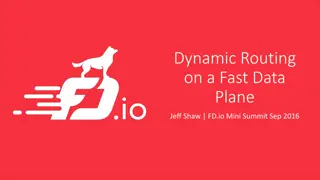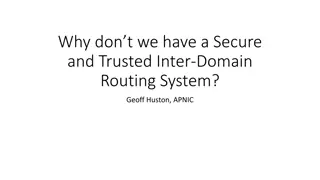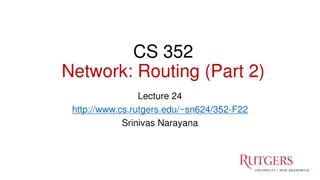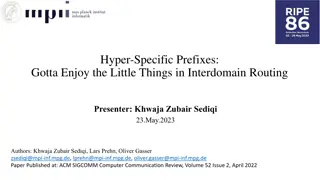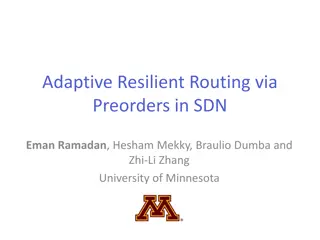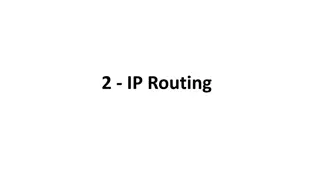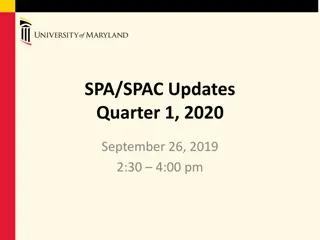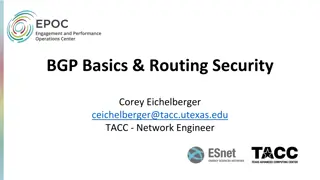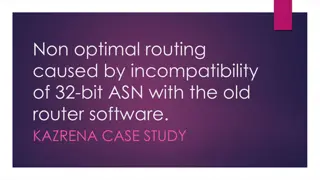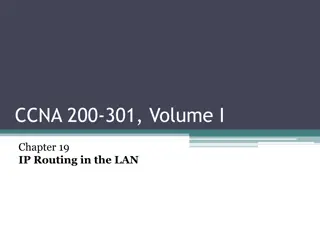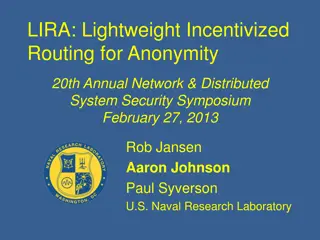Routing Algorithms: Intro
"Explore the fundamentals of routing algorithms and network layers in computer science. Learn about the design of Google Maps for the Internet, the functions of the network layer, and the graph abstraction used in routing algorithms. Discover how routing algorithms determine good paths from source to destination, considering factors like cost, propagation delay, bandwidth, and congestion."
Download Presentation

Please find below an Image/Link to download the presentation.
The content on the website is provided AS IS for your information and personal use only. It may not be sold, licensed, or shared on other websites without obtaining consent from the author.If you encounter any issues during the download, it is possible that the publisher has removed the file from their server.
You are allowed to download the files provided on this website for personal or commercial use, subject to the condition that they are used lawfully. All files are the property of their respective owners.
The content on the website is provided AS IS for your information and personal use only. It may not be sold, licensed, or shared on other websites without obtaining consent from the author.
E N D
Presentation Transcript
CS 352 Routing Algorithms: Intro CS 352, Lecture 18.1 http://www.cs.rutgers.edu/~sn624/352 Srinivas Narayana 1
Network Application FTP HTTP HTTPS SMTP DNS Transport UDP TCP IP Network X.25 802.11 ATM Host-to-Net The main function of the network layer is to move packets from one endpoint to another.
How would one design a Google Maps for the Internet?
Review: Network layer functions Forwarding: move packets from router s input to appropriate router output Data Plane Control Plane Routing: determine route taken by packets from source to destination routing algorithms Two kinds of control planes: Distributed per-router control Logically centralized The network layer solves the routing problem. The next 2 lectures
Review: Per-router control plane Distributed control plane: Components in every router interact with other components to produce a routing outcome. Routing Algorithm control plane data plane Data plane per-packet processing, moving packet from input port to output port 0111 1 2 3 values in arriving packet header, i.e, destination IP address
Goal of Routing Algorithms Determine good paths from source to destination Good = least cost Least propagation delay Least cost per unit bandwidth (e.g., $ per Gbit/s) Least congested (workload-driven) Path = a sequence of router ports (links) Routing is a fundamental problem in networking.
The graph abstraction Routing algorithms work over an abstract representation of a network: the graph abstraction Ex: Rutgers campus 5 3 v w u: Computer Science v: School of Engineering 5 2 u z 2 1 3 1 2 x y 1 Each router is a node in a graph Each link is an edge in the graph Edges have weights (also called link metrics). Set by admin
The graph abstraction Routing algorithms work over an abstract representation of a network: the graph abstraction Ex: Rutgers campus 5 3 v w u: Computer Science v: School of Engineering 5 2 u z 2 1 3 1 2 x y 1 G = (N, E) N = {u, v, w, x, y, z} E = { (u,v), (u,x), (v,x), (v,w), (x,w), (x,y), (w,y), (w,z), (y,z) }
The graph abstraction Cost of an edge: c(x, y) Examples: c(u, v) = 2, c(u, w) = 5 Cost of a path = summation of edge costs c(path x w y z) = 3 + 1 + 2 = 6 5 3 v w 5 2 u z 2 1 3 1 2 x y 1 Outcome of routing: each node should determine the least cost path to every other node Q1: What algorithm should each node run to compute the least cost path to every node? Q2: What information should nodes exchange with each other to enable this computation?
The rest of this lecture Routing protocols Distance vector protocols Link state protocols Each router has complete information of the graph Each router only maintains distances to other routers Information shared by flooding over the network Messages are exchanged over each link and stay within the link Message exchanges expensive Message exchanges cheap
CS 352 Link State Protocols CS 352, Lecture 18.2 http://www.cs.rutgers.edu/~sn624/352 Srinivas Narayana 12
Review: Routing & Link State Algorithms Distributed routing protocols 5 3 Goal of routing algorithms: find least cost path in a graph abstraction of the network v w 5 2 u z 2 1 3 1 2 x y Link state algorithm: Each router has full visibility of the graph, i.e., the states of all links 1 Routing protocols Q1: what algorithm runs at each node? Q2: what information is exchanged? Link state protocols Distance vector protocols
Q2: Information exchange Link state flooding: the process by which neighborhood information of each network router is transmitted to all other routers Each router sends a link state advertisement (LSA) to each of its neighbors LSA contains the router ID, the IP prefix owned by the router, the router s neighbors, and link cost to those neighbors Upon receiving an LSA, a router forwards it to each of its neighbors: flooding 5 3 v w 5 2 u z 2 1 3 1 2 x y 1
Q2: Information exchange Eventually, the entire network receives LSAs originated by each router 5 3 v w 5 2 u LSAs occur periodically and whenever the graph changes Example: if a link fails Example: if a new link or router is added z 2 1 3 1 2 x y 1 The routing algorithm running at each router can use the entire network s graph to compute least cost paths
Q1: The algorithm Notation: c(x,y): link cost from node x to y; = if not direct neighbors D(v): current estimate of cost of path from source to destination v p(v): (predecessor node) the last node before v on the path from source to v N': set of nodes whose least cost path is definitively known Dijkstra s algorithm Given a network graph, the algorithm computes the least cost paths from one node (source) to all other nodes This can then be used to compute the forwarding table at that node Iterative algorithm: maintain estimates of least costs to reach every other node. After k iterations, each node definitively knows the least cost path to k destinations
Dijsktras Algorithm 1 Initialization: 2 N' = {u} 3 for all nodes v 4 if v adjacent to u 5 then D(v) = c(u,v) 6 else D(v) = 7 8 Loop 9 find w not in N' such that D(w) is a minimum 10 add w to N' 11 update D(v) for all v adjacent to w and not in N' : 12 D(v) = min( D(v), D(w) + c(w,v) ) 13 /* new cost to v is either old cost to v or known 14 shortest path cost to w plus cost from w to v */ 15 until all nodes in N' Initial estimates of distances are just the link costs of neighbors. Least cost node among all estimates. This cost cannot decrease further. Relaxation 17
Visualization min cost in N \ N W should move to N . N N \ N nodes whose least cost paths from u are definitively known Nodes with estimated least path costs, not definitively known w v Relaxation: for each v in N \ N , is the cost of the path via w smaller than known least cost path to v? If so, update D(v) Predecessor of v is w. v u v Cost of path via w: D(w) + c(w,v) Cost of known best path: D(v)
Dijkstras algorithm: example D(v),p(v) D(x),p(x) D(w),p(w) D(y),p(y) Step N' u ux uxy uxyv uxyvw uxyvwz D(z),p(z) 2,u 2,u 2,u 1,u 5,u 4,x 3,y 3,y 0 1 2 3 4 5 4,y 4,y 4,y 2,x 5 3 v w 5 2 u z 2 1 3 1 2 x y 1
Constructing the forwarding table To find the router port to use for a given destination (router), find the predecessor of the node iteratively until reaching an immediate neighbor of the source u The port connecting u to this neighbor is the output port for this destination
Constructing the forwarding table 5 Suppose we want forwarding entry for z. 3 v w 5 2 u z 2 1 3 1 2 x y 1 z: p(z) = y y: p(y) = x x: p(x) = u x is an immediate neighbor of u D(v),p(v) D(x),p(x) D(w),p(w) D(y),p(y) D(z),p(z) 2,u 1,u 3,y 2,x 4,y destination link Forwarding table at u: z (u,x)
Summary of link state protocols Each router announces link state to the entire network using flooding Each node independently computes least cost paths to every other node using the full network graph Dijkstra s algorithm can efficiently compute these best paths Easy to populate the forwarding table from predecessor information computed during the algorithm
CS 352 Distance Vector Protocols CS 352, Lecture 18.3 http://www.cs.rutgers.edu/~sn624/352 Srinivas Narayana 24
Review: Routing & Dist Vector Algorithms Distributed routing protocols 5 3 v w Goal of routing algorithms: find least cost path in a graph abstraction of the network 5 2 u z 2 1 3 1 2 x y 1 DV proto: Each router maintains a vector of distances to all other routers; not the graph. Routing protocols Q1: what algorithm runs at each node? Q2: what information is exchanged? Link state protocols Distance vector protocols
Q2: Exchanged info = Distance Vectors Nodes exchange distance vectors with their neighbors No flooding unlike link state protocols. Message not propagated further Dx(y) = estimate of least cost from x to y Distance vector: Dx = [Dx(y): y N ] Node x knows cost of edge to each neighbor v: c(x,v) Node x maintains Dx Node x also maintains its neighbors distance vectors For each neighbor v, x maintains Dv = [Dv(y): y N ] Nodes exchange distance vector periodically and whenever the local distance vector changes (e.g., link failure, cost changes) 26
Q1: Algorithm Bellman-Ford algorithm Each node initializes its own distance vector (DV) to edge costs Each node sends its DVs to its neighbors When a node x receives new DV from a neighbor v, it updates its own DV using the Bellman-Ford equation: Given dx(y) := estimated cost of the least-cost path from x to y Update dx(y) = minv {c(x,v) + dv(y) } cost of path from neighbor v to destination y minimum taken over all neighbors v of x cost to reach neighbor v directly from x
Visualization Neighbor v sends its distance vector to x. Which neighbor v offers the current best path from x to y? Path through neighbor v has cost c(x,v) + dv(y) Choose min-cost neighbor Remember min-cost neighbor as the one used to reach node y This neighbor determines the output port for the packet. v v x dv(y) v y Use v and link (x,v ) to reach y. v
Q1: Algorithm Bellman-Ford algorithm By iteratively performing Bellman-Ford iterations, under some conditions, the estimate dx(y) converges to the true cost of the least cost path from x to y.
Dx(z) = min{c(x,y) + Dy(z), c(x,z) + Dz(z)} = min{2+1 , 7+0} = 3 Dx(y) = min{c(x,y) + Dy(y), c(x,z) + Dz(y)} = min{2+0 , 7+1} = 2 node x table cost to cost to cost to x y z x y z x y z x y z 0 2 7 x y z 0 2 3 x y z 0 2 3 from from from 2 0 1 7 1 0 2 0 1 3 1 0 node y table cost to cost to cost to x y z x y z x y z y 2 1 x y z x y z 0 2 7 2 0 1 7 1 0 x y z 0 2 3 2 0 1 3 1 0 z from x from from 2 0 1 7 node z table cost to cost to cost to x y z x y z x y z x y z 0 2 7 2 0 1 x y z 0 2 3 x y z from from from 2 0 1 7 1 0 3 1 0 3 1 0 time
Good news with distance vector protocols Suppose the link cost reduces or a new better path becomes available in a network. The immediate neighbors of the change detect the better path immediately Since their DV changed, these nodes notify their neighbors immediately. And those neighbors notify still more neighbors until the entire network knows to use the better path Good news travels fast through the network This is despite messages only being exchanged among neighbors 1 y 4 1 x z 2
Bad news with distance vector protocols If router goes down, could be a while before network realizes it. A B C D E Count to infinity problem 1 2 3 4 Initially 3 2 3 4 After 1 exchange 3 4 3 4 After 2 exchanges 5 4 5 4 After 3 exchanges 5 6 5 6 After 4 exchanges 7 6 7 6 After 5 exchanges etc to infinity
Bad news travels slowly Reacting appropriately to bad news requires information that only other routers have. A B C D E B needs to know that C has no other path to A other than via B. Poisoned reverse: if X gets its route to Y via Z, then X will announce dX(Y) = in its message to Z Effect: Z won t use X to route to Y However, this won t solve the problem in general (think why.) Fundamentally, DV protocols must exchange more information to react robustly to network changes and router errors.
Summary: Comparison of LS and DV Link State Algorithms Nodes have full visibility into the network s graph Message complexity is high: each LSA is flooded over the whole network In general, robust to network changes. Scope of incorrect info is limited to bad LSAs. Distance Vector Algorithms Only distances and neighbors are visible Message complexity is low: DVs are exchanged among neighbors only Brittle against bad news and router bugs: incorrect info can propagate throughout a network
Deployed routing protocols The algorithms we ve seen are widely deployed in real ISPs Link-state protocols OSPF (Open Shortest Path First) IS-IS: (Intermediate System to Intermediate System) Distance-vector protocols RIP: Routing Information Protocol IGRP: Interior Gateway Routing Protocol You re likely watching this video over a network running one of these protocols to determine how data should reach your machine.
